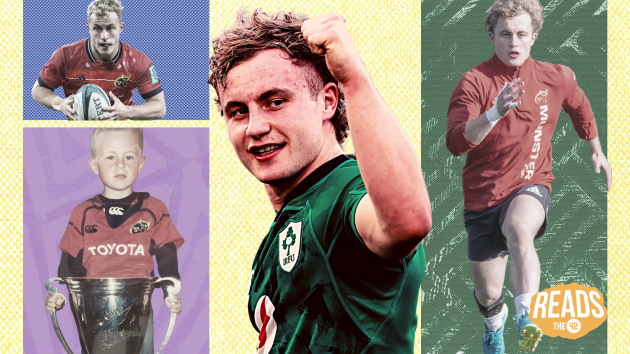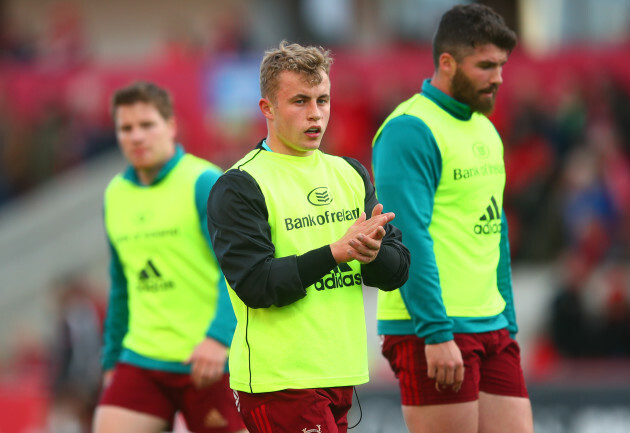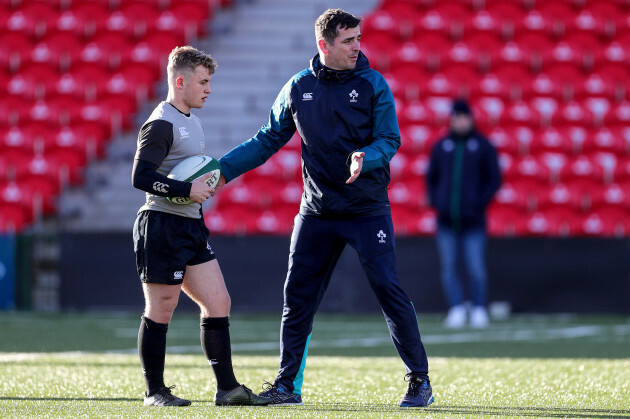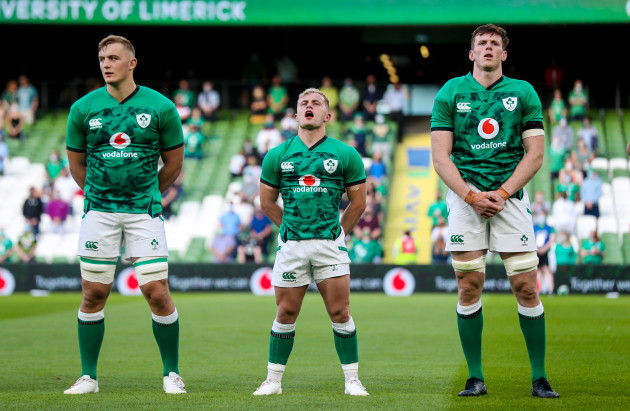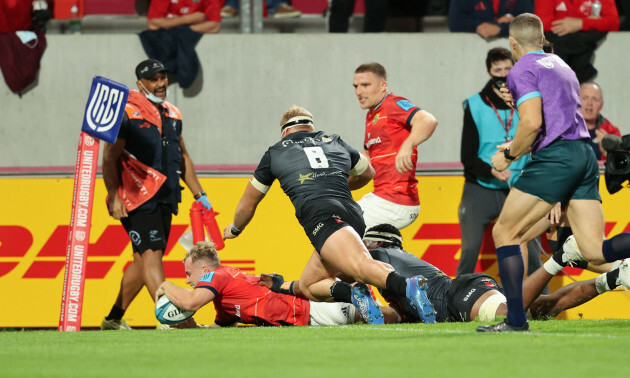IT WAS EARLY spring, 2019. A grandmother stacked away the last of the dishes, stuck the kettle on and started looking among the cushions for the remote control, the remainder of her Saturday dependent on the success of her search.
It was a chilly enough evening, and as the grandmother stretched to close the kitchen window, she could hear the sound of cheering carried downwind from Thomond Park. It was match-night, Connacht the visitors, the game live on television.
She knew her son and daughter-in-law had tickets for the West Stand and guessed they had taken their seats by the time she was listening to Michael Corcoran describe the scene on RTÉ radio. “News is just reaching us that Conor Murray has tweaked a neck injury in the warm-up,” Corcoran said. “As a result, Neil Cronin comes in to the Munster starting line-up at scrum-half with 20-year-old academy player, Craig Casey, set for his debut, after being promoted to the bench.”
The grandmother remembers another cheer, this time a raucous one, travelling downtown from Thomond, and from a lifetime’s experience, knew the teams had taken the pitch. In her head, though, the voice on the radio was way louder than any roar: academy player Craig Casey has been promoted to the bench.
The grandmother gasped and rushed to her phone. Six texts, all more or less saying the same thing. “Craig’s going to be playing! Craig’s going to be playing!”
- See sport differently with The42 Membership and get closer to the stories that matter with exclusive analysis, insight and debate. Click here to find out more>
She found the remote, switched on the TV but didn’t pay any attention to the game, instead scanning the sideline and end-goal area where the replacements were warming up, seeing if she could spot him.
No luck. By half-time she was on her feet, grabbing her coat, switching off lights, locking doors.
She was on her way. The stadium was five minutes away. She got there in three, getting a few funny looks off the smokers outside Fitzgerald’s Pub as she raced by, the floodlights in the distance beckoning her towards them, like moths to a light.
She was practically running by the time she got to the entrance of Thomond Park, approaching the steward on the gate.
“I’m sorry,” he said, his arm outstretched, blocking her path. “It’s ticket only.”
“I’m Craig Casey’s grandmother,” she replied, half out of breath, “and my grandson’s playing in there. Will you please let me in?”
The steward sensed there was a time to uphold the rules and a time to break them. The gate swung open, the steward deliberately looking the other way. With that, Mary Casey was gone. Eleven minutes later, another Casey, this one a scrum-half, had arrived.
NO RUGBY PLAYER in Ireland has generated as much excitement in the subsequent weeks and months as the Munster number nine. Part of you wonders why that is, and part of you knows the answer stems from the fact Munster and Ireland have been stuck in a bit of a rut for some time, the 2019 World Cup going south, just like one semi-final after another for the province.
There’s more to it than just that, though. Everyone likes it when the boy next door makes it onto the big stage, and everyone by now knows Casey was Munster’s mascot for a 2006 Celtic League match, and that his uncle, Mossy Lawler, scored one of the tries against Gloucester in the Miracle Match. Those with a deeper knowledge of the rugby scene in Limerick have also joined the remaining dots; that Ger, his father, was on the Shannon coaching ticket when they won the AIL in 2009; that Colm Tucker is a relation by marriage on his mother’s side; that Ter Casey, an Irish international in the 1930s, is on his dad’s side of the family.
The thing that really provokes such a strong connection, though, is his size. Craig Casey is five foot, five inches. “Five foot, five-and-a-half. Don’t forget the half,” laughs Ger, his father.
He’s been listening to people harp on about his son’s height since he first brought him to mini rugby 19 years ago. “I was coaching the seniors down at Shannon, and Shannon is that kind of club where it’s common enough to have the young fella in and around training all the time. Sure, during the warm-ups, yer man joined in, from the time he was six, seven, throwing dummies, dancing in and around the big fellas.”
The fellas were always bigger but Ger didn’t pay any heed because Ger knew his rugby and knew his son. “I don’t see my size as a drawback,” Craig would later say.
And it never was. “All the evasion skills, his speed of thought, it was developing from a young age because even if he was always very strong for his size, he was always competing against taller and stronger boys,” says his father.
When coaching him at Shannon, later with Ardscoil Rís, Ger would routinely hear players or parents scoff. “‘Would you look at the size of your man?’ they’d say.” And time after time it made him smile because time after time he’d see his son slalom his way through a forest of defenders. One year, in a schools game, he scored all 32 points against Crescent Comp in a 32-0 win.
Noel McNamara saw that match. By this stage he was in charge of Irish Schools. “You knew he was special,” he says. “You just knew.” He brought Casey to Wales for a Schools international, watched as the side trailed 24-10 at half-time, and introduced Casey for the second half. With his first touch, Casey made a line break, before popping a pass up for Scott Penny to score under the sticks.
Seated in front of McNamara, Rob Howley – the former Welsh coach and British and Irish Lion – turned around.
“You’ve made some changes here, boy.”
They worked. Ireland won 38-36.
“Any time I’ve seen Craig, first as a schoolboy, as recently as two weeks ago when he played us (McNamara now coaches in South Africa with the Sharks) he has had this capacity to shape games,” says McNamara. “He has a magnetic personality, is unbelievably hard working, the first guy out at training, the last to leave. His mindset to constantly get better is relentless.
“Let me put it to you another way, a team that has Craig Casey in its dressing room is in a good place, not just because he’s a brilliant player, but also because his personality is infectious. He relates to everyone, players, physios, coaches. That’s rare. He’s one of the best people I’ve been lucky enough to coach.”
In Limerick, where Casey is already a treasure, McNamara’s story fits into the city’s image of the star. They’ve heard about him singing Piano Man in dressing rooms after big wins; they’ve probably seen the childhood pictures of him with Foley, Ronan O’Gara, Christian Cullen. For his communion, Mossy Lawler, his uncle, got him Peter Stringer’s shirt.
Another Munster scrum-half, Mike Prendergast, knew all about him before the world had been let in on the secret. “You’d always see him around training or matches; like I grew up not that far from him and his dad, and Mossy and I are great friends. When you are from Limerick, rugby is just such a massive part of who we are. Everyone is connected in some way.”
That can be both a blessing and a curse. Whenever Prendergast pulled on the red jersey, he was acutely aware of the responsibility that went with it. “You knew your friends, your family, were following you, so you didn’t want to let them down,” he says. “So, yeah, there was pressure, but pressure in a good way. To be honest, it drove you more because it was so local. I see that drive in Craig.”
A PORTRAIT OF a precocious talent was emerging. Casey was fearless, sublimely talented and blissfully entertaining. All his pals were. They’d shine on a Gaelic football field, moving through the age groups, winning all around them. Casey was a decent soccer player too, good enough to play Kennedy Cup, where he missed a penalty for Limerick in a third/fourth place play-off against Cork. “After that he said, ‘Dad, I’ll just concentrate on rugby from now on’.”
Neither parent was pushy because soccer too was in the blood, Bud Aherne, a great uncle, playing in one of Irish soccer’s most famous wins, the 2-0 victory over England at Goodison Park in 1949. “As a parent you just want your kids happy and healthy.”
They were. Aimee, his daughter, is a supremely talented gymnast, good enough to represent Ireland, like Sinead, their mum. Night after night, Aimee and Craig competed ferociously to see who could do the most push-ups. Aimee always won.
It all appeared perfect but then, at 18, it wasn’t. A problem in his left knee was compounded by an ingrowing hair on his back. When that was sorted, a fresh problem emerged in his opposite knee. In all, he missed 14 months. “Yet he never complained,” says Ger.
There was a good reason for that. While Craig was recovering from knee surgery, Aimee was diagnosed with scoliosis and had to learn how to walk again. “That made him resilient, seeing what she was going through,” says Ger. “Mentally he became very strong. He knew all the stuff he had to do (exercise wise) and he just became really diligent at it.”
Mike Sherry could see that. By the time Casey was making his way into the Munster set-up, Sherry was preparing to step away from it, their paths crossing in the gym.
“It was like he was in there 24/7,” says Sherry. “This was his year recovering from those injuries and we were all blown away by his level of commitment. One small example of what he does to get the best out of himself is his attitude to coffee. He enjoys it but won’t have it during the week so that when it comes to pre-game, he will drink it then to get as big a rush as possible. He is constantly training, constantly asking questions.”
Looking at him now, his rise to prominence with Munster and Ireland seems inevitable. It wasn’t. His injuries came at a time when some players mature and others fall out of love with the game. “Mentality wise, at that age it is about staying in the fight,” says Sherry. “There are times in every young player’s career when you are caught between two stools, between the club game and the professional game. You have to be very selfish.
“It can be very hard when you are not given opportunities, when you are giving up your weekends, when you are not going away for the summers like your buddies in college might be, when you are not able to go to parties, but when you do get your break, all that stands to you. That has been the case with Craig. He had those injuries but his commitment didn’t waver. It is paying dividends now.”
In fact, it was being repaid two years ago. A string of sensational performances for McNamara’s U20 grand slam winning team saw him attract serious interest from Leinster, as well as two unnamed English clubs, plus Connacht and Ulster.
While flattered, he was never going to leave. What would he say to Grandmother Casey if he did? Granny’s skills of evasion at the Thomond Park turnstile were now being matched by her grandson’s elusiveness on the pitch. In 31 games for Munster, he’s scored 32 points, and that’s before we mention the 465 passes he made last season, his Ireland debut in Rome, the Munster young player of the year award he picked up, his first international start against the US in June.
“That day was special,” says Ger, “being one of 3,000 people in the ground, hearing the national anthem played before the game.”
PRENDERGAST, THE FAMILY friend, watched that match, indeed watches all Casey’s matches, with a coach’s eye.
“Everyone knows about his energy,” says the Racing 92 backs coach, “but technically he is also a very good nine, a crisp passer, a smart runner, plus he has got a good kicking game. He has high standards which is very important. People feed off that. He brings energy, enthusiasm, excitement.
“Listening to how he is following different profile nines, like Faf de Klerk and Aaron Smith, you just know this guy is full on, in a very good way I mean, in terms of his preparation and the way he watches different nines and their style of play.
“And do you know what? He is going to carve out his own style. He’s smart and is only going to get better.”
That was the opinion Eddie O’Sullivan certainly had when we spoke about Casey a year ago, the three-time Triple Crown winning coach pointing out how a scrum-half often has to trick himself into believing he is the best player on the park. “Yet Casey’s confidence seems natural, not put on,” said O’Sullivan.
Confidence is healthy. Over confidence is not. For a player who isn’t shy to take tap penalties, there’s a concern he may fall into the trap so many players his age have in the past, seeking the risky option rather than the sober choice.
“That wouldn’t be a worry I’d have for Craig at all,” says McNamara, his belief stemming not just from what he saw Casey do to his Sharks side two weeks ago, when he scored the game-changing try, but also from the person he got to know when they worked together in the Irish Schools and U20s sides.
“When you talk about any rugby player, I’d never disassociate the person from the player,” says McNamara. “For me, they are one and the same thing and Craig is just a fantastic guy.
“So yes, he’s young, and yes, young players will make mistakes. That’s the reality. It’s whether they learn from them or not. Craig does. He’s studious.”
And he’s self-critical. “Very much so,” says Ger, his father.
Even after the Sharks game a fortnight ago, when he was named player of the match, he got back home and watched the game over and over again, pressing pause and rewind, looking for the things he got wrong, rather than gorging on all he got right.
“When we prepped for that Munster match, we certainly would have spoken about the threat he poses,” says McNamara, “and certainly would have spoken about the importance of not underestimating that threat. The thing about Craig is there is not one thing to worry about. You can’t just say, ‘Look out for his quick tap penalties; stop those and you’ll be fine’. He has a running game, a passing game, a kicking game. He is not your typical Irish scrum-half.”
In what sense? “Well, we played a slightly different game at Schools and U20s level, based on speed, a game of movement and quickness, Craig the absolute catalyst for that. While he is energetic, a force of nature, he is also unbelievably technically good.
“The core skills for a scrum-half, he has all those. His passing quality is absolutely first-class; the quality of his kicking game is as well; he is a left footer which brings its own positives; his game-management and understanding of the game is of a very high level. He tends to make good decisions. He is able to execute what he sees.”
TELLINGLY IT WAS interesting that in each separate interview, Prendergast, Sherry, Casey senior and McNamara made a point of how Conor Murray has unselfishly mentored him. The apprentice is now a rival, and in many neutral’s eyes, ready to permanently replace his tutor. Le Petit General was McNamara’s affectionate nickname for Casey. Others have mentioned how the kid is focused on becoming the best number nine Munster have ever had.
“Nothing was going to stop him getting to where he wanted to go,” says Duncan Williams, the scrum-half that Casey effectively replaced on the Munster roster. “I remember him one day, we were training on one pitch, he was with the Under 19s on the field opposite, and he was running around hitting fellas about 20 kilos heavier than him.
“For a small man he is very brave, he does not shirk tackles.
“He puts himself about which is something I would admire because it is not an easy game when you have big men running at you. Maybe that is why he picked up all the injuries when he was younger, putting himself in places he should not have been near. He’ll learn that eventually.
“You learn more as you get older. He’s putting a bit of pressure on Conor (Murray). I’d imagine things will keep going in that trajectory.”
As for his father, well it’s four years since he last coached him. These days he and Sinead are spectators, seated in the Thomond Park stands, their seats directly in front of Ger Earls, Keith’s father. That’s Limerick. It may be a city but there’s a proximity to everything, an inter-connection. Earls Senior and Casey Senior played with and against one another in the ’80s and ’90s. Then, when Keith was breaking through in 2007, Mossy Lawler ‘minded him’. Over the last three years, Keith has returned the favour for Lawler’s nephew.
“The last number of years,” Ger Casey says, “they’ve just been amazing. The U20s grand slam, the U20s World Cup in Argentina, we were over for 28 days at that. You couldn’t miss it. You kind of think where is this going to end? You are looking at your young fella facing the junior All Blacks’ haka and you’re thinking, as a rugby man, ‘Jeez this is mad, absolutely surreal’.
“No doubt about it, it has been a brilliant journey.”
It’s only starting.
See sport differently with The42 Membership and get closer to the stories that matter with exclusive analysis, insight and debate. Click here to find out more>
* Duncan Williams is part of Rugby Players Ireland’s reboot campaign as former players have come together to encourage men of all backgrounds and fitness levels to take control of their health and Reboot their Lives this September. Men all over Ireland can sign up to Reboot their lives and find lots of helpful tips and information at irishheart.ie.

